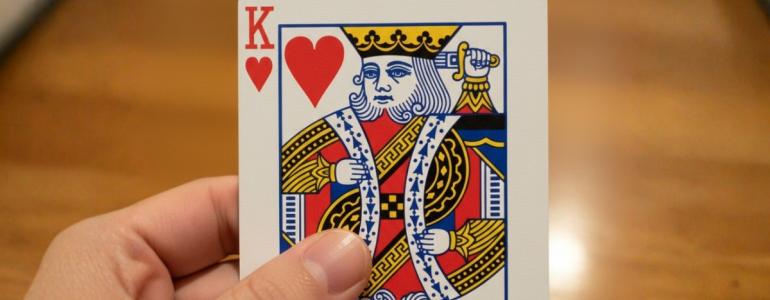Why the King of Hearts Is Called the Suicide King
1 day ago

29 Oct
Among every deck used in online casinos and online poker sites, one card stands out for its strange design. The King of Hearts, often called the “Suicide King,” shows a sword pointed toward his head. The image looks dramatic, but it wasn’t planned that way.
The effect came from centuries of small design errors passed through printing presses. What started as a normal royal portrait became one of the most recognizable quirks in card history.
What is the Suicide King Card?
The suicide king card is the King of Hearts. He holds a sword that appears to pierce his head, creating an illusion that inspired the nickname. No other king in a standard deck carries his weapon in this position.
This odd detail turned the heart king into an object of curiosity. Players and collectors began referring to him as the “Suicide King,” long before mass production standardized the deck design.
Despite the name, the card was never drawn to suggest harm or sorrow. It became a printing artifact mistaken for symbolism.
Origins in Historical Card Design
The history of the suicide king playing card design traces back to early French patterns from Rouen and Paris in the 15th century. Card makers relied on woodblocks that wore down after repeated use. When they replaced or copied them, fine details were often lost. Early versions showed the King of Hearts holding a curved axe. Over time, engravers redrew the image with a straight sword, and the angle shifted toward the head.
English printers adopted this French pattern in the 18th century, reproducing it across Europe and America. The sword placement survived through habit, not intent. Once the design became standard, card makers kept it unchanged for recognition. What began as a technical simplification turned into a permanent feature of the deck.
Is the King Actually Stabbing Himself?
The image suggests violence, but the cards’ suicide king illusion comes from printing limitations, not intent. Three main factors shaped the appearance:
- Flattened perspective. Early card engravers lacked depth tools, so objects appeared two-dimensional. The sword was meant to rest behind the king’s head, but the missing shading collapsed the space, merging the blade with the crown. Without contrast or shadow, the weapon and face lines blurred together, making the action appear fatal.
- Line merging. Repeated copies of worn wooden templates erased fine detail around the king’s neck and hair. The missing outlines caused the sword hilt and headpiece to connect visually, creating the illusion of penetration. Later reprints simply traced those merged lines without correction, embedding the mistake in future decks.
- Ink shifts. Early printing presses often misaligned color layers by a few millimeters. When red and black ink drifted, the blade’s edge overlapped facial contours, adding to the illusion. Every print run slightly changed the overlap, so no two old decks looked identical, yet most carried the same illusion of danger.
Together, these issues created a picture that looked self-inflicted, though it was only poor alignment. Once card printing moved to machines, the same art style was reused for consistency. The visual remained strange but familiar to players.
Artistic Variations in Modern Decks
Modern printers and card sets interpret the suicide king cards design in various ways. Some manufacturers adjust the sword angle or redraw the hilt to separate it from the face. Digital decks used in top rated online casinos often soften the blade’s outline or place it behind the crown to reduce confusion.
Custom card creators sometimes replace the sword with alternative symbols such as scrolls or feathers. Others redesign the king with clearer perspective lines. Despite the small updates, most decks still use the same outline found in historical patterns. The goal is familiarity—players recognize the card instantly, both at tables and on screens.
Myths and Cultural Interpretations
Over time, the suicide King of Hearts gained symbolic interpretations. Some players connected the sword to loyalty or sacrifice. Others associated it with passion because of the heart suit. These readings came from imagination, not from the artists who made the cards.
In casual conversation, the name adds humor or tradition to card play. It never carries a dark or literal tone. The image entered folklore because players repeated the story, not because it represented an event or legend. The mix of error and repetition created a myth that traveled across generations.
The Suicide King in Modern Card Culture
The image of the suicide king playing card continues to influence art, media, and design. Its strange mix of familiarity and mystery keeps it relevant across different forms of creative work.
- Tattoo art: The king often appears in tattoo designs as a symbol of self-discipline, strategy, or control under pressure. Artists emphasize the sword and crown to represent inner conflict or perseverance rather than despair. Many card players choose it as a quiet nod to patience and calculation, linking the image to the mindset required in long poker sessions.
- Graphic design: Modern illustrators use variations of the Suicide King for logos, apparel, and digital branding. Designers reshape the figure with cleaner lines or stylized crowns, removing the old printing flaw but keeping the iconic pose. The card’s contrast of authority and fragility translates well into minimalist imagery for both gaming and lifestyle brands.
- Film and television: Directors occasionally insert the card into scenes involving luck, risk, or irony. Its instantly recognizable design gives visual shorthand for fate or tension without dialogue. The card’s presence reinforces themes of decision-making, matching how chance and control often intersect in gambling narratives.
- Merchandise: Clothing lines, accessories, and casino collectibles often feature the Suicide King for its nostalgic value. The design bridges traditional gambling culture and modern aesthetics, making it adaptable for commercial art. Whether on posters or custom chips, it keeps the centuries-old error visible to new generations of players.
These reinterpretations show how a printing flaw turned into a flexible cultural icon. Each appearance reshapes the image, yet the same curious sword keeps the story alive across both physical and digital decks.
Does the Nickname Affect Gameplay?
In poker, blackjack, and other card games, the suicide king card meaning is purely visual. The King of Hearts has equal rank to the other kings, and its nickname carries no special rule. On online poker sites, the card functions exactly the same in digital decks.
Casinos and manufacturers treat the design as part of card heritage. Its reputation influences conversation, not outcomes. Players may mention it during hands, but its value never changes. The card’s story belongs to art history rather than to gameplay strategy.
Popular Face-Card Nicknames and Meanings
Over the centuries, players gave the face cards memorable nicknames that stuck. All of these names reflect visual differences, not changes in card value or meaning.
- Suicide King (King of Hearts): Named for the sword’s placement against his head.
- One-Eyed King (King of Diamonds): Drawn in profile with only one visible eye.
- One-Eyed Jacks (Spades and Hearts): Known in poker slang for their sideways look.
- Man with the Axe (early King of Diamonds): Based on older versions before swords replaced axes.
- Queen with the Flower (Queen of Spades or Clubs): Often shown holding a blossom rather than a weapon.
The One-Eyed Kings and Other Face-Card Oddities
The King of Hearts is not the only face card with unusual artwork.
The King of Diamonds shows only one eye and is called the “one-eyed king.” This side profile was deliberate, added to give the face cards variation. The same applies to the “one-eyed jacks,” which include the Jack of Spades and the Jack of Hearts.
Some collectors even mention a suicide jack card, referencing old designs where the Jack of Clubs held his weapon near his head. These differences developed through regional printing patterns, not hidden meaning; each variation helped decks look distinctive at a time when few people could read card labels.
Wrap Up — King of Hearts, the Suicide King
The King of Hearts became the suicide king card through a long chain of printing changes, not by design or story.
A simple artistic distortion created one of the most recognizable images in modern playing cards — from early French workshops to digital decks used in casinos today, the figure stays identical in spirit.
What began as an accident now stands as proof that even small details can leave a lasting mark on card history.







Comments
You need to be logged in to post a new comment